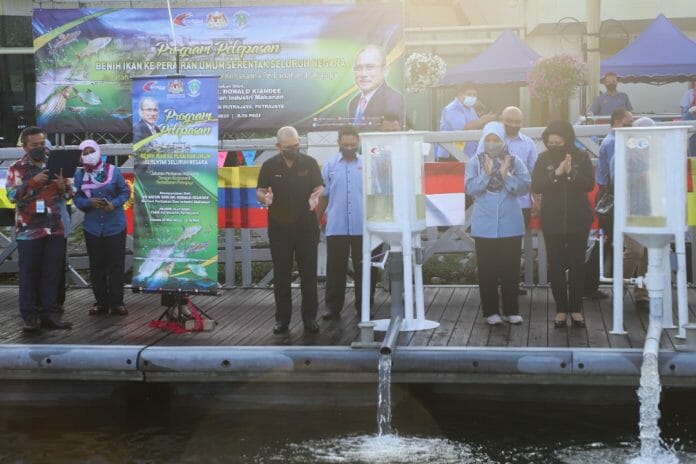The simultaneous release of fish seeds into public waters throughout Malaysia was held at Putrajaya Lake in collaboration between the Department of Fisheries Malaysia (DOF) and the Putrajaya Corporation. A total of 1.85 million seeds worth more than RM900,000 were released for the purpose of increasing fishery stocks.
Minister of Agriculture and Food Industry (MAFI), YB Datuk Seri Dr. Ronald Kiandee said the joint venture today was to ensure that the goal of preserving the environment as well as the conservation of inland fisheries resources and biodiversity, especially in Putrajaya Lake, could be achieved.
He added that the fish seed release program can give awareness to the public on the importance of conserving the inland fisheries ecosystem for future generations. The increase in fish stocks in public waters is also among the efforts to improve food security.
DOF calls on the public who own foreign fish as pet fish to be more responsible and not release the fish into public waters. This action will cause the fish in the area to fall prey to foreign fish that are more aggressive.
The release of fish seeds is an annual program made nationwide by the State Fisheries Department as a measure to ensure that land fish stocks are always available. It is important for the Fisheries Department to take consistent steps seriously in the management and conservation of inland fisheries resources as it can indirectly improve the socio-economy of local fishermen.
Among the seeds released in Putrajaya Lake are kelah fish, temoleh, river lampam, and lobster.
According to Fisheries Department records from 2016 to 2021, a total of 44.7 million seeds (worth more than RM50 million) were released into public waters throughout Peninsular Malaysia and the Sarawak Region, including from the Sarawak Agriculture Department.
It is important for the Fisheries Department to continue to manage inland fisheries resources so that they do not become extinct. This will affect the aquatic ecosystem chain and also reduce the supply of inland fisheries resources for consumers thus affecting the country’s food security.
The National Fisheries Development Plan 2021-2030 which has been published by DOF will balance aspects such as exploring the potential of fisheries resources in an efficient and sustainable manner. This will also ensure that the level of well -being of food producers in the fisheries and aquaculture sub-sectors can be further improved.
MAFI also invites the public to make freshwater fish as the main dish of Malaysians in addition to sea fish. The diversity of freshwater fish menu processing and innovation is seen as something interesting such as tilapia snowfish products, tilapia nuggets, grilled catfish, patin pais and seaweed juice drinks.
Dr. Ronald also encouraged each State Fisheries Department to hold a Freshwater Fish Eating Campaign in their respective states. This can attract more consumers to know and try freshwater fish other than catfish, tilapia, catfish which are synonymous with local consumers.
Datuk Jamal Abdillah who was appointed as the Fisheries Resource Conservation Icon will be involved in promoting fisheries programs/activities involving the conservation of fisheries and fishery products, especially in the ornamental fish industry and downstream products. He has also been operating an arowana fish farm located in Bukit Merah for about 10 years and is in high demand from ornamental fish enthusiasts abroad.
“High demand will increase the production of freshwater fish species, thus helping to generate income for farmers and operators of freshwater fish -based Agro-based Industry products and reduce dependence on imports,” he said.
Datuk Jamal Abdillah.
By 2030, the government targets the aquaculture sector to contribute 40% to Malaysia’s total fishery production.










